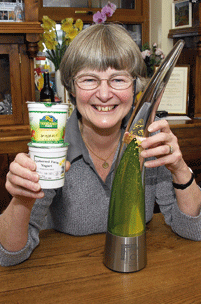Tread carefully when getting into on-farm processing

Producers attempting to boost profits by on-farm milk processing can easily become victims of their own success, according to a Carmarthenshire farmer.
Rosemary Jones started making additive-free yoghurt on Trebersed Farm, Traveller’s Rest, Carmarthen, in the mid-’90s, and the enterprise was so successful she was even visited by the Prince of Wales.
But now the stainless-steel processing equipment has been sold and the only remaining traces of the business are a few labelled yoghurt pots and the True Taste of Wales Gold Award she won.
Mrs Jones, who started production to enhance the profitability of the family’s dairy herd, says her experiences are a cautionary tale for other would-be processing entrepreneurs.
Three days a week she was converting 100 litres of milk – the capacity of the equipment, which was worth about £20, to yoghurt valued at more than £200 at the farm gate.
“People loved the product because our simple system did not involve forcing yoghurt through pipes, so the product was extra rich and creamy,” explained Mrs Jones during an NFU Cymru press open day on the farm.
“We produced 17 different flavours according to which fruits were in season, but the whole process was labour intensive and I was working three long days a week and still not satisfying growing demand.
“Eventually we reached a point where we had to invest a lot of money to double output. This would have happened, but I found it impossible to find the qualified key extra worker I needed.”
“I could not continue doing the job with just some part-time workers, particuarly as I wanted to spend some time with my grandchildren. I certainly could not consider expansion so, reluctantly, we decided further investment could not be justified.
“Perhaps if I had started the business 10 years earlier I would have been young enough to carry on, and I would advise anyone starting out to make sure they have the energy to cope with the hard work required to run a growing enterprise.”
Mrs Jones also suggested farmers planning to add value to their milk to work closely with environment health authorities at every stage to understand and comply with complex and demanding food processing and marketing regulations.
She warned while the differential between the value of milk in a farm’s bulk tank and after it is turned into a dairy product appeared attractive, profit margins were not huge.
“Processing can help a farm’s cash flow, but equipment is expensive and, when labour is fully costed in, it may not make a big contribution to overall farm profitability.”
Mrs Jones sees tremendous opportunities for marketing high-quality farm-made dairy products, but she cautioned there were many factors that could mean the grass on the other side of the fence was not as green as it appeared.
The yoghurt business developed in parallel with the dairy herd. Mrs Jones and her husband David moved to the 69ha (170-acre) farm in 1987 after deciding to downsize from the 300-cow enterprise they ran on another unit.
The plan was to run 100 high-yielding pedigree Holsteins and sell milk and heifers. For 15 months they milked through an old bail as the 107 heifers they brought with them calved down.
“It soon became obvious 100 cows would not be enough to make a reasonable living and keep the bank happy, but keeping more would be difficult on such a limited area of land,” said Mr Jones.
Instead of buying extra land, Mr Jones opted for keeping cows inside, except when they were stale or dry. Now he, his wife and son-in-law run 200 head averaging 9800 litres.
